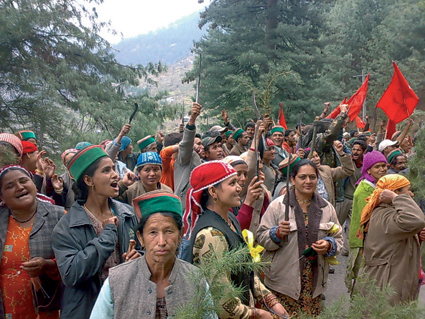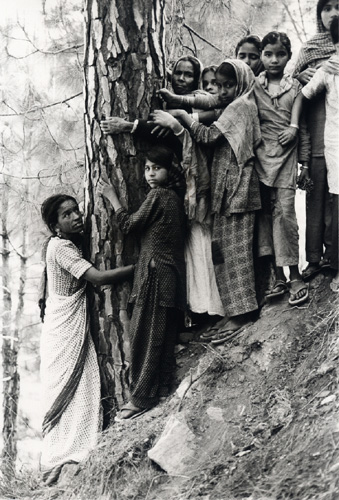 |
Peoples' movements and protests |
 |
|
MobilizationsNuclear resistance in EuropeNuclear resistance in SwedenThe Indian tree hugging movementForest protection in the AmazonThe dam resistance in the Narmada valleyThe GMO resistanceThe British motorway resistanceBack to Environmental movementsBack to main page |
The chipko movement
The villages of Uttarakhand in northern India have always stretched from the river up to the mountains. Just like a village in the Swedish mountain areas, they have been dependent on both soil and forest – forest for grazing and timber and wood. When the British colonial authorities handed over the forests to commercial forestry companies at the beginning of the 20th century, the peasants of course saw this as theft and took a stand against it. The picture above shows a group of peasant women in the neighboring province of Himachal who collectively invade a forest that the company sees as theirs to collect firewood. From 1911, a constant, uninterrupted struggle broke out between the villages and the forest companies, which consisted of the farmers sabotaging the felling in every way they could. They would rather burn the forest than let the forest companies benefit; a burned forest could always grow back, and by the way, controlled burning of sly was a way of maintaining the grass cover that the cows grazed. In addition to this everyday resistance, the peasants also appealed to the traditional Indian authorities that the English had left as vassal princes. In these cases, the campaigns could grow into broad popular movements in which the urban population also took part, as an element in the Indian struggle for independence. British forest companies were seen as representatives of the colonial power. The last uprising against the forest companies under British rule took place in 1947 and resulted in the peasants’ representatives taking over power in Uttarakhand. As good Indian patriots, of course, they handed it over to the new Indian central government, which promptly incorporated Uttarakhand into the state of Uttar Pradesh, which continued commercial forestry without delay. Whereupon the peasants again
raised their opposition. The Chipko campaign lasted from 1973 to 1980 and aimed to stop all deforestation. It was organized through the villages but leading Gandhians in the area acted as inspirers and liaisons to the Indian public. Chipko means ”hug”, and surrounding the trees to prevent sawing was one of many tactics.
The fact that the conflict of interest was presented as an environmental movement had both disadvantages and advantages. The advantage was that the movement spread throughout India and contributed to a strong political pressure in the country to limit the companies’ ravages and give the farmers greater rights to run their own forestry under cooperative auspices. The disadvantage was that the farmers were exposed to various bureaucratic, ill-conceived environmental protection measures on the part of the state. Ironically, Uttar Pradesh was one of the provinces that paid the least attention to the peasant forest movement. So the peasants once again shifted their focus. In 1994, they launched a campaign to break free Uttarakhand as their own Indian state, which became a reality in 2000. The Chipko movement is usually regarded as the first environmental movement in the southern countries – but apparently the environmental focus was secondary. It was primarily about saving the farmers’ economy against the theft of resources by transnational companies. In this way, the chipko movement has remained typical. Environmental movements in the south are most often about preserving a local population’s resource base against outside exploitation. Reading
|

